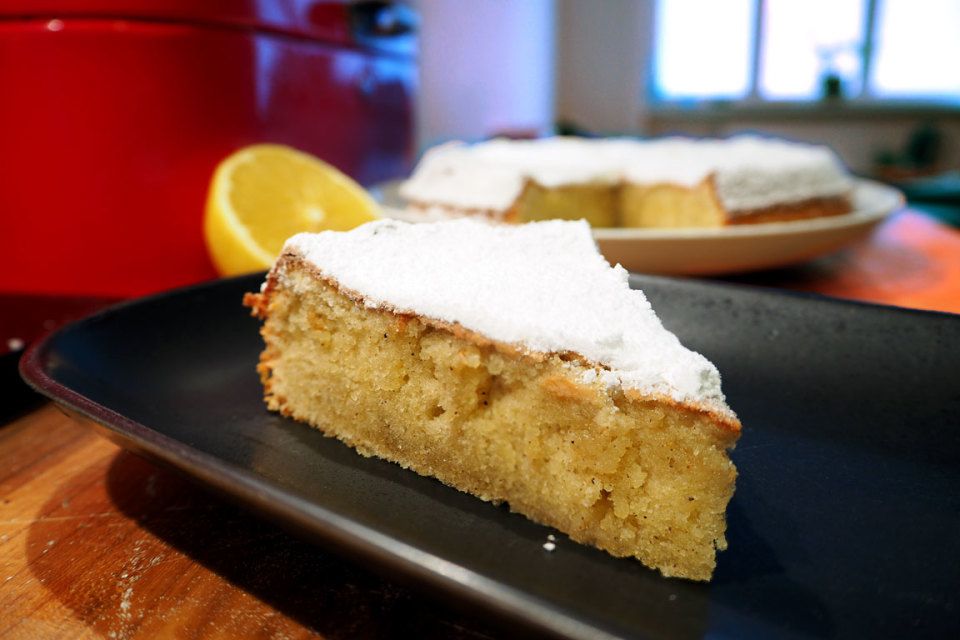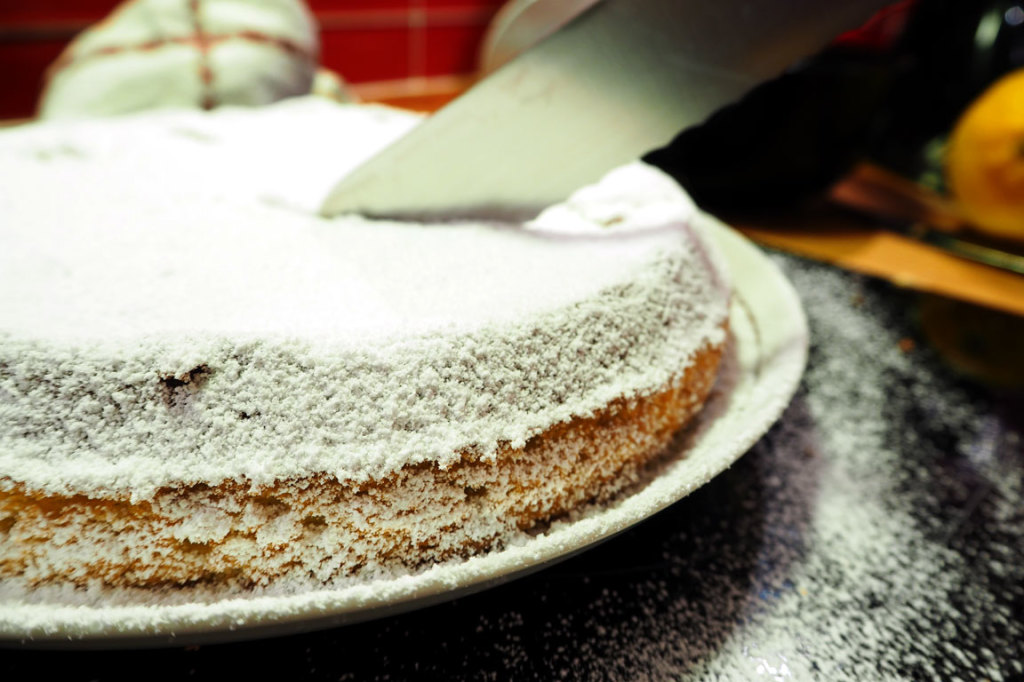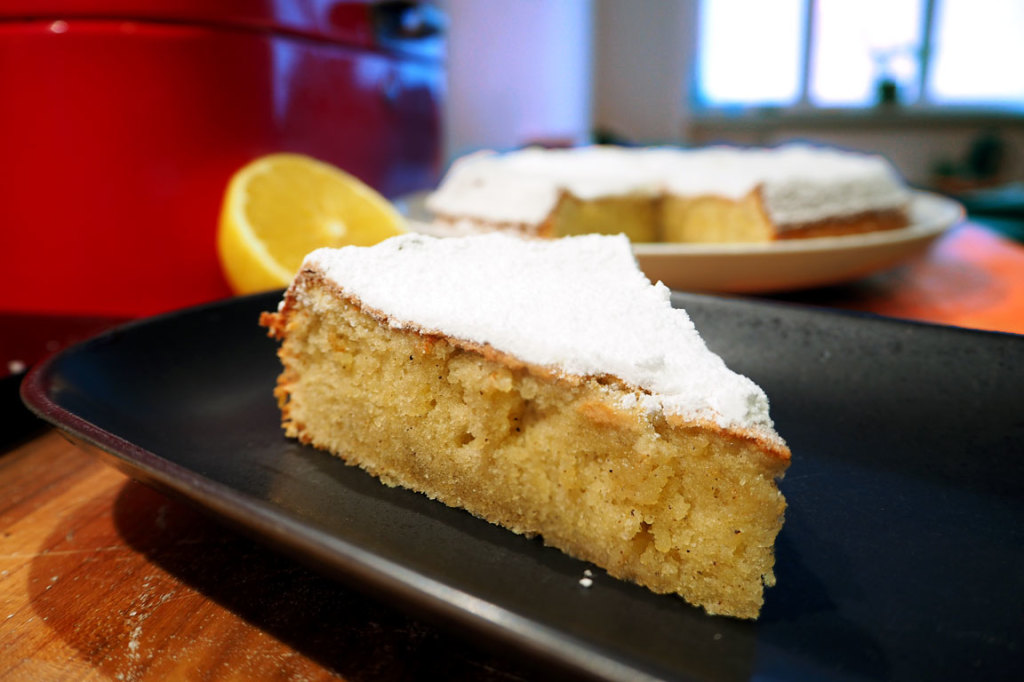Lemon and olive oil cake

I’m not really into generic sponge cakes. They’re rarely moist, because recipes call for way too long oven times, and people tend to over bake them and/or hold back on the fat, making the cakes stale after just a couple of hours. And then there’s this idea that you definitely need chemical leaven to make a cake fluffy. The problem with baking powder and baking soda is that it does give the cake a chemical flavor. It can be minimized by making sure that there’s just enough acid in there to neutralize the sodium bicarbonate, but I find that the method often fails. Unlike yeast-leavened creations where one could say “I like the yeasty notes”, I don’t think many people would say “I like that metallic sodium bicarbonate flavors in there”. However, as a matter of fact, you can make a cake leavened mechanically by whipping air into it. And that’s exactly what we’re doing with this lemon and olive oil cake. And the generous amount of olive oil not only gives it a wonderful flavor, but also keeps the cake moist for a long time. This olive oil cake is probably one of my favorite sponge cake recipes.
Time it takes
About 15 minutes to prepare the ingredients, and to mix it all up. And then about 30 minutes in the oven, but don’t look at the time. Look at the inner temperature!
Ingredients for a lemon and olive oil cake
- 160 g of sugar (a little more than 2 dl)
- 20 g of confectioner’s sugar
- 1 egg yolk (yes, real bakers will say that it depends on the size of the egg, but come on…)
- 110 grams of egg white (so egg white from about 3 average eggs)
- 25 g of lemon juice (2,5 cl, so about half a lemon)
- 3 vanilla beans (just the seeds, scraped out, or a teaspoon of pure real vanilla powder)
- 3 g of lemon zest (from about half a lemon, that is)
- 115 g of wheat flour (that’s about 1.92 dl, so just under 2 will do, it’s not a life or death situation. Some will say you need the industrially blenched stuff to get the right texture, but I prefer my organic one)
- 160 g of extra virgin olive oil (a little more than 1,7 dl, so just put in about 1 and 3/4 dl, and you’ll be fine)
- 8 g of salt (that’s about three pinches of salt. Use a good flaky sea salt, it tastes better and its quite pleasant to touch)
- And you’ll need two bowls or containers in which you can mix stuff.
This is how you make the lemon and olive oil cake
- Combine about 110 g of the sugar (1.2 dl), the egg yolk, all the lemon juice, all the vanilla bean seeds, and the lemon zest. Whisk it, either by using a stand mixer or the classic hand held type.
- Gradually sift all the flour into the sugar mix, while mixing.*
- Pour in olive oil in a slow stream. You don’t want the thing to separate, you want a nice consistent batter, so take it easy (there’s lemon juice in there, which is full of water, that doesn’t like fat). Set the mix aside.
- Into a new clean bowl, add all the egg whites and 2 g of salt (about one pinch, that is). Mix on high speed until the eggs are all foam. We’re not looking for meringue foam for the moment. Just generally foamy.
- Gradually add the rest of the sugar.
- Now mix the heck out of those egg whites, until they form peaks, and you can pretty much turn the bowl upside down without the content falling out.
- Gently fold the egg whites into the batter. I use a spatula and do it one third at a time, incorporating while at the same time trying not to beat the air bubbles out of the mixture. You see, as I mentioned in the introduction, we’re using mechanical leaven here (the tiny air bubbles are our friends)
- Set the oven to 165°C / 329°F.**
- Coat a 22 cm (about 9″) springform pan with butter and dust it with flour. Pour batter into pan.
- Pour batter into the pan, and place it in the oven. Stick a thermometer in the olive oil cake batter.*** When the inner temperature of the cake is 95°C, it’s done. Take it out and let it cool completely.
- Once the olive oil cake has cooled, mix the confectioner’s sugar with the rest of the salt (about two pinches) and sprinkle it over the cake. It looks very generous, but it’s excellent. The saltiness and the sweetness works absolutely wonderful. As a matter of fact, salt has the effect that it makes sweet taste even sweeter.
Recipe notes
* If you have a friend holding a hand mixer, then you’re all set. If not, then I guess you have to stop, sift in a little, mix, and then stop again.
** I recommend you buy an oven thermometer, so you can check what the actual heat in there is. Don’t trust your oven knobs. Unless you have an extremely expensive oven that controls the heat in there and keeps it constant.
*** Using time as a unit of measurement, is really bad. The cake often turns out undercooked or dry. Instead, buy a cheap meat thermometer.


